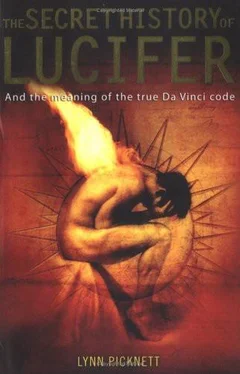Abandon hope, all ye ...
Citing the biblical authority of Exodus 22:18 `Thou shall not suffer a witch to live' - although the kasaph of the original text actually means `seer' or clairvoyant, ironically in the same paranormal category as the exclusively male prophets - the Holy Office waded into the bloody fray, arresting, interrogating and murdering countless people.60 But of what were they accused?
Many were simply ugly old women, no doubt senile and unpleasant, or who those had fallen foul of their neighbours. Their constant mumbling was taken as the invocation of devilish spells - or even a direct prayer to Old Nick himself. Conversely, a particularly pretty girl was often accused of witchcraft, often by jealous peers or a thwarted would-be lover, especially if he was a priest. Denunciations of witchcraft represented the ultimate in harassment and bullying: human nature being what it is, the temptation was tragically too great to pass up an opportunity of settling old scores when the Inquisitors came to town.
One woman was arrested because she quarrelled with her neighbour, who then saw a snake in her garden. If horses bolted, crops failed, butter stubbornly remained milk, children sickened, women miscarried, there was always a handy witch to blame. Another woman was convicted and burnt because she had rowed with a drunk at a tavern, who - how strange! - found himself up all night vomiting. Yet another poor wretch found herself facing the flames because she had been seen pulling off her stockings - and shortly afterwards her neighbour became lame. Two Scottish `witches' were hanged because they had treated, and cured an ailing child. As Barbara Walker notes:
Joan Cason of Kent went to the gallows in 1586 for having dry thatch on her roof. Her neighbour, whose child was sick, was told ... that the child was bewitched, and it could be proved by stealing a bit of thatch from the witch's roof and throwing it on the fire. If it crackled and sparked, witchcraft was assured. The test came out positive . . 61
Women with dissimilar eyes or red hair were instantly recognizable as devil worshippers: apart from the symbolism discussed previously, perhaps this was because redheads usually have freckles, and these were often taken as `witch marks'. The Inquisitors made it known as a fact that witches bore certain special marks on their bodies, where the devil had touched them as an affirmation of their unholy pact, and which remained impervious to pain. Part of the torturers' job was to strip and search the accused for the `Devil's teat', jabbing a large bodkin into their flesh, which - although it caused great suffering - was not even categorized as torture. Then, with swift sleight of hand, the `witch pricker' substituted a retractable bodkin and, lo and behold, the mark was found! Of course witch pricking offered the perfect opportunity for all manner of violent sexual abuse, but again, this was deemed the torturer's perk and not part of being `put to the Question', or torture proper.
At a witch trial in 1593, as the jailer searched a female `witch' - which of course he did thoroughly - he discovered `a little lump of flesh, in manner sticking out as if it had been a teat, to the length of half an inch', which he `perceiving at the first sight thereof, meant not to disclose, because it was adjoining to so secret a place which was not decent to be seen; yet in the end, not willing to conceal so strange a matter"' he did show it to others. They all agreed - married men and all - that this was new in their experience, and almost certainly demonic. The woman was convicted and burnt. This `devil's teat' was, of course, a clitoris. Even physicians believed that no virtuous woman would possess such a thing633 - an interesting application of the theory of predestination.
At Lille in 1661, the pupils of alleged witch Antoinette Bourignon confessed:
The Devil gives them a Mark, which Marks they renew as often as those Persons have any desire to quit him. The devil reproves them the more severely, and obligeth them to new Promises, making them also new Marks for assurance or Pledge, that those Persons should continue faithful to him.'
The twentieth-century's own would-be Inquisitor, the Reverend Summers, expounds without so much as a flicker of irony on this, `the most important point in the identification of a witch ... the very sign and seal of Satan . . .'6' Nevertheless, in his eagerness to prove his case, Summers is nothing if not thorough in providing a wide spread of sources, which possess a quaint horror for those of more balanced minds. He cites Robert Hink, `minister at Aberfoill', in his Secret Commonwealth (1691), who noted:
A spot that I have seen, as a small mole, horny, and browncoloured; throw [sic] which mark, when a large pin was thrust (both in buttock, nose and rooff of mouth), till it bowed and became crooked, the witches both men and women, nather felt a pain nor did bleed, nor knew the precise time when this was doing to them ...
Summers informs us breathlessly that, `This mark was sometimes the complete figure of a toad or a bat; or ... the slot of a hare, the foot of a frog, a spider, a deformed whelp, a mouse' .66 Note the `foot of a frog' - a vague description if ever there was one - or that `deformed whelp', which might be almost any shape or size: indeed, as many people would have borne some kind of birthmark or blemish on their person, who should emerge blameless?
(Summers also argues that heretics had a particularly loathsome smell, as indeed they probably did - terror does generate a markedly acrid sort of sweat. Besides, even a single night in the Inquisition's jails would render the most fragrant somewhat malodorous. However, of course, to Summers Catholic priests often exuded the odour of sanctity, as evidence for which he remarks in utter seriousness `I myself have known a priest of fervent faith who at times diffused the odour of incense' 67 Surely it would be a very odd thing if most priests did not `at times' smell of incense! One may laugh, but this sort of infantilism - nice people smell nice but nasty people smell nasty - smacks too much of Dr Goebbels' anti-Semitic propaganda, lapped up by millions of ordinary intelligent Germans, to be anything other than chilling.)
Summers quotes `that same authority' on the site of such `Witch Marks': `In men it may often be seen under the eyelids, under the lips, under the armpits, on the shoulders, on the fundament; in women, moreover, on the breast or the pudenda. 161 Ah. But remember that wherever these marks were `found' they were located by having a skewer-like bodkin, usually about three inches long, rammed into the near-locality `till it bowed and became crooked'. And this still was not officially classed as torture.
Summers explains that the `Little Teat or Pap' so found on the body of a wizard or witch, and said to secrete milk that nourished the `familiar' - a demon-possessed creature such as a cat or toad - must be carefully distinguished from the insensible devil-mark. This, for some reason, was a phenomenon more or less exclusive to England and New England, in the days when witch hysteria had moved seamlessly from the Inquisition to the dour Protestant Fathers. (Of course Montague Summers dismisses cases of Protestant exorcism as merely the fantasies of poor afflicted country folk, whereas the Catholic version is always a genuine spiritual feat.)
In 1597 Elizabeth Wright of Burton-on-Trent
the old woman they stript, and found behind her right sholder a thing much like the vdder of an ewe that giuth sucke with two teates, like vnto two great wartes, the one behind vnder her arme-hole, the other a hand off towardes the top of her shoulder. Being demanded how long she had those teates, she answered she was borne S0.69
The poor old woman's birthmark or defect effectively signed her death warrant.
Читать дальше












